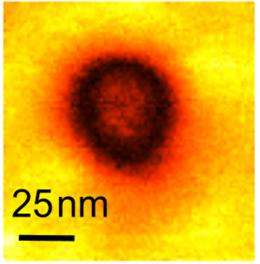Experiments prove nanoscale metallic conductivity in ferroelectrics

(PhysOrg.com) -- The prospect of electronics at the nanoscale may be even more promising with the first observation of metallic conductance in ferroelectric nanodomains by researchers at Oak Ridge National Laboratory.
Ferroelectric materials, which switch their polarization with the application of an electric field, have long been used in devices such as ultrasound machines and sensors. Now, discoveries about ferroelectrics' electronic properties are opening up possibilities of applications in nanoscale electronics and information storage.
In a paper published in the American Chemical Society's Nano Letters, the ORNL-led team demonstrated metallic conductivity in a ferroelectric film that otherwise acts as an insulator. This phenomenon of an insulator-metal transition was predicted more than 40 years ago by theorists but has eluded experimental proof until now.
"This finding unambiguously identifies a new conduction channel that percolates through the insulating matrix of the ferroelectric, which opens potentially exciting possibilities to 'write' and 'erase' circuitry with nanoscale dimensions," said lead author Peter Maksymovych of ORNL's Center for Nanophase Materials Sciences.
From an applied perspective, the ability to use only an electric field as a knob that tunes both the magnitude of metallic conductivity in a ferroelectric and the type of charge carriers is particularly intriguing. Doing the latter in a semiconductor would require a change of the material composition.
"Not only can we turn on metallic conductivity, but if you keep changing the bias dials, you can control the behavior very precisely," Maksymovych said. "And the smaller the nanodomain, the better it conducts. All this occurs in the exact same position of the material, and we can go from an insulator to a better metal or a worse metal in a heartbeat or faster. This is potentially attractive for applications, and it also leads to interesting fundamental questions about the exact mechanism of metallic conductivity."
Although the researchers focused their study on a well-known ferroelectric film called lead-zirconate titanate, they expect their observations will hold true for a broader array of ferroelectric materials.
"We also anticipate that extending our studies onto multiferroics, mixed-phase and anti-ferroelectrics will reveal a whole family of previously unknown electronic properties, breaking new ground in fundamentals and applications alike," said co-author and ORNL senior scientist Sergei Kalinin.
More information: The full paper, "Tunable Metallic Conductance in Ferroelectric Nanodomains," is available at pubs.acs.org/doi/full/10.1021/nl203349b
Provided by Oak Ridge National Laboratory

















